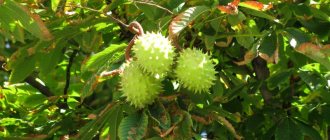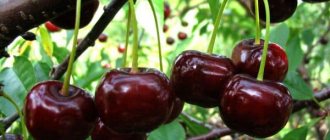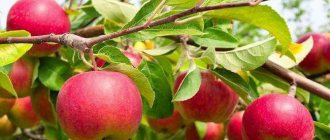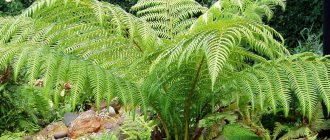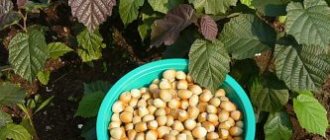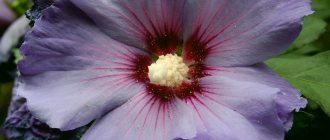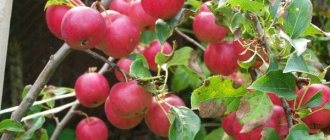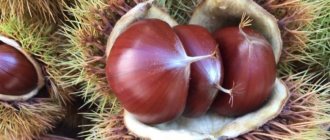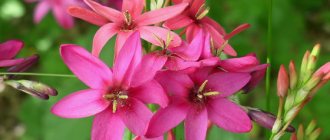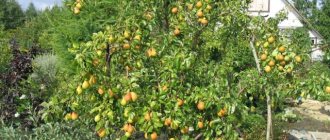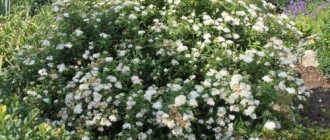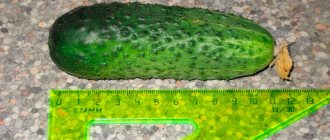Tree "Chestnut": planting and care, propagation
I grew a chestnut from a nut about eight years ago, and now it grows beautifully under my window in a country house.
Looks very good! I like chestnut leaves - large, with teeth, they have a peculiar volume (they seem to be corrugated). When I was growing it, I was, of course, worried: will it work? Will the tree in which so much hope has been invested die? But the chestnut turned out to be a “tough nut to crack”; it grew quickly; after planting in open ground, it turned out that it is not afraid of frost (we are talking about central Russia).
But until he was four years old, he grew up in a greenhouse. I grew the tree using technology, but there is nothing complicated about it. If you follow my steps, you will have a strong, tall tree with beautiful leaves, a straight trunk and gorgeous flowers.
By the way, the chestnut tree blooms for two whole weeks! This is a wonderful sight and joy for the whole family, as well as another reason to grow a chestnut tree yourself and plant it near the house.
In this article I will tell you how to plant a chestnut tree and how to grow a nut seedling.
Transfer
The young plant loves warmth very much. Therefore, he is very afraid of sub-zero temperatures and night frosts. The best time to transplant sprouted seeds is when the risk of a drop in temperature is minimal, that is, the end of May.
Chestnut is a large tree. This feature must be taken into account when choosing a suitable place for a seedling in the garden or on the site. If you want to plant several plants, then the distance between them should be more than 3 meters. If this condition is met, an adult chestnut will delight you with a thick crown, beautiful buds during the flowering period, as well as fruits with an amazing taste.
Advice!
The tree feels good in almost any soil, but if possible, it is preferable to plant seedlings in ordinary black soil. This guarantees a long life span as well as high productivity.
A bright place is suitable for the seedling. The main thing is that it should not be exposed to direct sunlight, which can negatively affect the young sprout.
Before planting the future chestnut tree in open ground, it is necessary to prepare an ordinary planting hole in advance. It must completely fit the root system of the seedling. The sprout should be planted only in specially prepared soil. To do this, you need to take soil from a dug hole, humus and sand in a ratio of 2:1:1 and 500 grams of slaked lime. You also need to add some fertilizers that contain potassium and phosphorus to the planting hole. Pebbles, crushed stone and sand can be used as drainage. The main thing is to make a layer about 10 cm high.
When planting a seedling, extreme care must be taken so as not to damage the root stem. This is done in compliance with the following recommendations:
- Pour the prepared soil mixture into the planting hole.
- Moisten the soil well.
- Place the seedling straight.
- Sprinkle evenly with soil on all sides.
- Completely compact the soil.
- Water the future tree.
Advice!
In order for the seedling to take root well and continue to develop properly, it can be covered with a paper bag for several days. This will speed up the growth of the tree.
Chestnut is an unpretentious tree for garden decoration
Chestnut is a very beautiful tree with a unique appearance. It has a wide, spreading crown, the height of the tree reaches 25 m. Closer to October, the fruits ripen on the tree, and it also looks very stylish.
By the way, many types of chestnut have inedible fruits. So don't count on having a source of tasty nuts. No, in the northern zones chestnuts have more decorative value. But the trees are really good and do an excellent job with their main role - decorating the land.
Planting, caring for, and propagating chestnut trees is not particularly difficult. The main thing is to grow a viable seedling, and then the tree will grow on its own.
In fact, there are many options for chestnut propagation:
- Cuttings;
- By layering;
- Root suckers;
- Seeds.
How to choose a landing site
When planting a chestnut, it is important to choose a good place, this will guarantee that in the future the tree will turn green and grow quickly. The chestnut tree needs the sun like it needs air! This is why growing chestnuts in northern latitudes is problematic.
It is also important to ensure that there are no buildings, sheds, large trees, or gazebos near the location you choose. There must be space within a radius of 5 m! Chestnut is a fairly large plant and needs a lot of space.
Thus, the requirements for the landing site are as follows:
- High illumination,
- Sufficient space for the root system,
- Space for the crown of the future tree (a 5 m radius space should be free).
Planting a seedling
The chestnut root system has an interesting feature - it is superficial. Therefore, after choosing a good place, you still need to prepare the soil so that the tree is comfortable.
High-quality drainage is needed: a layer of sand or a mixture of sand and clay should be placed in a prepared hole up to 60 cm deep. This is done to prevent the roots from rotting: stagnation of water is detrimental to chestnut.
Most often, horse chestnut is planted in the fall. Alternatively, it can be planted in early spring. When planting, it is important to make sure that you do not bury the root collar in the ground - it should be at soil level. As soon as planting is completed, it is necessary to water the seedling abundantly (at least 3 buckets of water per 1 tree).
While the tree is very young, it can be damaged by an animal or wind. To prevent this from happening, you need to install supports on four sides.
Peculiarities of propagation of chestnut from walnut
As I already mentioned, the method of growing chestnuts from walnuts is very attractive. This will be your tree, which you grew yourself from a small chestnut tree. It's not difficult to do this. You will need, in fact, only fully ripened fruits and time - about 3-4 years. Which fruits are suitable for our purposes:
- fallen to the ground themselves,
- whole,
- undamaged,
- no traces of disease or rodent damage,
- without traces of rot.
In the fall, collect several ripe chestnuts and place them in a covered container with wet sand. This is how artificial stratification is carried out (without it, the chestnut will not sprout). The chestnut should lie in the sand for some time, for example, until spring. Everything is like in nature! Indeed, under natural conditions, the chestnut fruit rests in cool soil before germinating.
Closer to spring, you can get a nut and soak it in warm water (this is an imitation of warm spring rains). The water needs to be changed from time to time (monitor the condition). When the nut has a softened peel, you can plant it in a pot.
The tree will soon sprout, and with the first warm days you can put it in the sun, in the yard. If you live in a warm climate, the chestnut tree can grow in a pot and spend the winter in a greenhouse for the first three years.
If you live in the middle zone, then it is advisable to grow the chestnut to a more mature state - it should winter in a greenhouse for about 5 years. But no more! The chestnut must harden and get used to external conditions.
In summer, it is advisable to water the young tree with soft water, loosen the soil, and feed it. Mature chestnuts do not require such care, but in case of drought, it is advisable to water the tree additionally (in the evening).
It is advisable to fertilize in early spring; cow manure is perfect. Also in the fall, chestnuts are prepared for wintering by feeding them with a special mixture: 15 g of nitroammophoska per 10 liters of water.
If you wish, you can prune the chestnut to form a symmetrical crown; it takes pruning well.
Care
Sprouting nuts yourself at home is actually not such a difficult task. The main thing at first is to provide the plants with proper care, as well as protect them from adverse weather conditions and various animals and birds.
To protect the future chestnut, you can use pegs. They are driven into the ground around the seedling and then tied with red rope. This will make the planting site visible to all household members, as well as guests who may unknowingly cause harm to the plant.
If the chestnut grows in an area characterized by strong gusts of wind, then the seedling should be tied to a reliable support so that it is not damaged in difficult and unfavorable conditions for a fragile tree.
The process of growing chestnuts takes a long time. If the seedling has taken root well and is properly cared for, then by the second year of life it will grow by only 20-25 cm, and by the 5th year it will reach 1.5 m. A dense crown begins to form closer to the 10th year of the plant’s life.
Chestnut: description, planting and tree care
Chestnut is a beautiful ornamental tree that has become a real decoration of household plots and streets of many cities. A wide crown of unusually beautiful leaves gives shade and coolness, and delicate flowers provide a pleasant light aroma. Some varieties of chestnut have tasty fruits.
Article on the topic: Thick elm description and features
Thanks to its ability to grow in almost any climatic conditions, chestnut has become a decoration of parks. This tree is most often found in the southern regions of Russia, the Caucasus, and Central Asia. It is used as a crop to decorate city streets, park alleys, and garden plots.
A mature horse chestnut tree reaches a height of 30 meters. The crown of a tree can be shaped like a ball, a pyramid, a column, or have a weeping shape like a willow.
The leaves are large, palmate with a dense surface and green, golden or variegated in color.
Chestnut inflorescences have the shape of a brush. The flowers, depending on the variety, are simple or double, colored white, yellow, pink or red.
The flowering period begins in May , but if there is an increase in temperature in winter, chestnut flowers may bloom.
Fruit ripening occurs at the end of August - beginning of September. Chestnut fruits are edible and taste similar to sweet potatoes. They are also used in folk medicine to prepare tinctures.
Edible chestnut: growing, planting, care
Edible chestnut
To begin with, let us clarify that the trees in parks and city streets that beautifully bloom with candles are horse chestnuts with inedible (but medicinal) fruits. In the future we will talk about edible chestnut.
The height of the tree varies from 1 to 35 m, depending on the type and variety. It blooms very beautifully: pyramidal inflorescences will decorate the garden from late May to mid-July.
Chestnut nuts
Chestnut fruits are enclosed in cozy shells (each with 1 to 3 nuts), protected by thorns.
Chestnuts bloom and bear fruit beautifully in gardens and parks in southern and central Russia. They prefer open sunny places.
Chestnut trees are bright individualists. No matter how hard you try, nothing will grow under them, because the chestnut creates a very thick shadow, and its powerful surface roots do not allow other crops to develop successfully. But this disadvantage can easily be turned into an advantage. You can install garden benches under the chestnut tree, where on hot summer days it will be pleasant to hide from the scorching rays of the sun.
Varieties
Horse chestnut is the most common type of this plant. In addition to it, other species are grown:
- California chestnut . This species is native to western North America. The height of the tree reaches 10 meters. It has a straight trunk. The main advantage of the tree is its white flowers with a pinkish tint, reaching a diameter of 20 centimeters;
- meat-red chestnut . Distributed in Crimea, the south of the Baltic states, and Ukraine. An adult plant can grow up to 25-30 meters. The leaves are dark green in color, with a dense, leathery surface. The flowers are collected in racemes and are dark pink or dark red. This chestnut variety needs a lot of moisture and does not tolerate hot, dry summers;
- yellow chestnut . The chestnut variety is widespread in the eastern part of America. A tree up to 30 meters high has a pyramid-shaped crown. The leaves are wedge-shaped with serrated edges. The lower part of the leaf blade is painted golden yellow. This variety of plant tolerates lower temperatures in winter more easily than others and blooms somewhat later than other species;
- small-flowered chestnut . Unlike other representatives of this species, it has a bushy form and reaches a height of 5 meters. Planting small-flowered chestnut can create dense thickets. The leaves consist of several small leaflets, the lower part of which has a grayish tint;
- Pavia or red chestnut . It grows in the eastern United States. The plant can have a woody or shrubby form. Its height reaches 10-20 meters. The flowers are painted a rich red color. The fruits are smooth and have no bristles;
- Japanese chestnut . The height of the tree is 30 meters. The trunk is straight, smooth, the main branches are spreading. The leaves are quite large, reaching a length of 16 centimeters. The flowers are yellowish-white and collected in inflorescences. The fruits are pear-shaped.
Types of Edible Chestnuts
In nature, there are just over 30 species of chestnut trees and shrubs. Here are several types of chestnut trees whose fruits are eaten.
European chestnut
Chestnut sowing is a noble, slender tree up to 35 m high with a regular ovoid crown. The leaves are large, lanceolate, 25-30 cm long. The inflorescences are spike-shaped, light yellow in color. The nuts are large, enclosed in a round fluffy cocoon. Chestnut is a long-liver; under favorable conditions, it can live in one place for up to 500 years, and in natural conditions – even longer.
Chestnut
Chinese chestnut is the softest
Chinese chestnut is a beautiful tree up to 15 m high, with spreading branches and finely toothed leaves. Chinese chestnut nuts are famous for their unsurpassed taste.
Chinese chestnut is the softest, photo from monadnockfirewood.com
Japanese chestnut or crenate
Originally from Japan, China and Korea. It grows quickly and begins to bear fruit early (2-4 years after planting). The fruits are the largest among edible chestnuts, up to 6 cm in diameter and up to 80 g in weight. More than 100 varieties with tasty large nuts have been bred in Japan.
Japanese chestnut (crenenate)
Among gardeners and gardeners, horse chestnut is more valued for its decorative qualities. Its luxurious crown, strewn with lush candlesticks of inflorescences, is simply breathtaking, and you want to admire this magnificent creation of nature again and again. You can read about horse chestnut and its cultivation in the publication Horse chestnut - an ornamental healer.
Growing chestnuts in the garden
Every gardener with experience in growing plants can grow a beautiful spreading tree on his plot. To do this, you need to follow simple rules for planting and caring for chestnuts.
When deciding to plant horse chestnut, you should know that the tree requires a lot of space . In order for the crown to develop well and form correctly, the distance from the tree to the nearest buildings or other plantings must be at least five meters. Only in this case will the horse chestnut develop normally and will not oppress other plants.
Caring for horse chestnut is simple ; practically no other plants grow in the shade of the tree, which allows you to create a resting place under its crown.
When planting a chestnut, remember that the tree requires significant space, good lighting and protection from cold winds and drafts.
Chestnut is shade-tolerant, but flowering occurs only with good sunlight.
For seedlings, a large area is chosen, since the plant’s powerful root system and spreading crown require a lot of space.
In order for the tree trunk to be smooth and not deformed, the plant should not be exposed to gusts of wind and constant drafts.
Young plants are planted in open ground in the spring , when the soil warms up. It is not recommended to plant seedlings in the fall, as they can be damaged by rodents in winter.
Chestnut requires slightly acidic, nutritious, loose soil. The tree grows well on loamy or chernozem soil. Dense soil is not suitable for plants, since the root system will not be able to develop normally. When planting, care should be taken to ensure drainage to avoid moisture stagnation.
Selection of seedlings
- For planting, you should choose young three-year-old plants or slightly older ones. Young plants can be transplanted to a new location until the plant is 10 years old.
- For seedlings, cubic-shaped planting pits up to 60 centimeters deep are prepared, on the bottom of which a drainage layer of fine crushed stone and sand, nutritious soil made of humus and dolomite flour is laid.
- When planting, do not bury the root collar. The planting hole should be slightly higher, since after some time the soil will settle and the tree trunk will be exposed. After planting, the seedlings are watered and supports are installed to protect them from the wind. They are removed when the root system has sufficiently developed and strengthened.
An adult chestnut tree easily tolerates a lack of moisture. Watering is necessary if the summer is very hot and there is no rain for a long time. Regular watering is required only for young plants.
Weeding and loosening
Weeding of the soil around young plantings should be carried out regularly. It is usually combined with shallow loosening of the soil and weed control.
As the tree grows, the need for these measures disappears, since the dense crown suppresses growth near any plants.
During pruning, a lush, spreading crown of the tree is formed. To do this, in the spring the upper branches are cut to ¼ of the length. Side shoots that grow in summer are not pruned. This pruning is carried out every year until the tree reaches the required height.
When pruning, 5 strong side shoots are left. After crown formation is completed, no pruning is carried out.
Sanitary pruning is carried out regularly in spring. It allows you to remove dried and pest-damaged branches.
When pruning young plants, the regrown shoots are shortened by half their length. In summer, thin branches should be removed. This will help prevent crown thickening.
After the pruning is completed, the cut areas are treated with garden varnish.
Reproduction
Chestnut is propagated by cuttings and seeds.
Article on the topic: Paper birch description and features
- Cuttings
The cuttings are taken in the fall, after the bark of the main plant has matured and the buds have formed. For planting, cuttings up to 30 centimeters long with 5-7 well-developed buds are required. They are placed in planting boxes filled with sawdust for rooting.
- Propagation by seeds
For seed propagation, well-ripened, whole, undamaged nuts are used. Seed germination is possible only after stratification, which under natural conditions occurs in fallen leaves, where the nuts overwinter and sprout in spring.
At home, for stratification, nuts are placed in damp sand and stored in a cool room for two to five months. Before planting, they should be immersed in warm water. This will soften the shell and break down the substances it contains that prevent germination.
Then the seeds are planted in open ground in a garden plot to a depth of 10 centimeters. You can also plant them in small pots. In this case, planting can be done without waiting for the onset of spring, and at the end of May the seedlings can be transplanted to a personal plot.
If you shorten the taproot slightly when replanting, a strong superficial root system will develop in the future. Caring for seedlings includes regular loosening of the soil, weeding and watering. In the second year after planting, the seedlings must be thinned out.
Feeding and fertilizer
Fertilizers are applied annually in early spring. As a top dressing, a composition of ammonium nitrate, urea, phosphorus-potassium fertilizer and manure is used.
You can also use compost, grass infusions, and humus with added mineral fertilizers for fertilizing.
Before applying fertilizers, the soil is mulched using peat, sawdust and wood shavings, which will later become a good fertilizer for the tree.
Preparing for winter
Chestnut easily tolerates winter frosts, but still needs additional preparation for cold weather. Protection from low temperatures and cold winds is necessary for young plantings in the first 3 years.
To prepare the plant for winter, you should mulch the tree trunk circle and cover the trunks with burlap or non-woven covering material. This can avoid cracks in the bark. If they do appear, they are treated with an antiseptic solution and garden pitch.
Pest and disease control
Chestnut is susceptible to the development of fungal diseases, powdery mildew, and anthracnose. To eliminate diseases, as well as for preventive purposes, trees are treated with Bordeaux mixture and other fungicidal agents.
Among the insect pests that most often attack trees are Japanese beetles, borers, bagworms and the previously unknown Balkan moth. Insecticidal preparations are used to control pests.
To prevent diseases and breeding of pests, you should burn fallen leaves during the autumn cleaning of your garden plot.
Home variety
You can even grow a chestnut alley at your own dacha or on the site of a country house. To do this, it is not necessary to buy expensive seedlings. You can easily grow a tree from a nut yourself at home. The main thing is to correctly follow all the recommendations of experienced gardeners and agronomists.
Today, more than 30 varieties of chestnuts are known. But not everyone is suitable for growing a tree at home. It is better to opt for one of the following options:
- Seeding chestnut.
The plant is a long-lived plant. The average lifespan of one tree is approximately 500 years. The tree grows up to 35 meters and has large leaves that form a fairly dense crown. During the flowering period, lush flowers are formed, which are painted in a delicate cream shade. When ripe, the fruits are large in size. They are protected by a soft shell. Nuts are edible and suitable for preparing various exotic dishes. - The softest Chinese chestnut.
One of the most unusual and interesting varieties, which is highly valued due to the amazing taste of the fruit. The tree itself grows relatively small - only 15 meters in height. The trunk is framed by small downward pubescent leaves. - Japanese chestnut.
A distinctive feature of the variety is the rapid growth of the tree. Already in the 3rd year of life it is able to bear fruit. Edible nuts have an interesting taste and weigh about 100 grams.
If the dacha plot has a small area, then you need to properly allocate space for the chestnut. Do not forget that the tree has a dense crown and a strong root system located near the surface of the earth. These features will become the main obstacles to the cultivation of a number of other crops. It is best to arrange a relaxation area for all household members and their friends.
Carefully!
In order for chestnut to have beneficial properties for the human body at home, it must be grown away from highways, as well as hazardous industries and factories for various purposes. Chestnut is able to quickly absorb toxins, heavy metal fumes and other emissions, which can subsequently negatively affect human health.
Almost all types of edible chestnuts do not have the ability to withstand the winter period. Therefore, trees need additional shelter during cold weather. Once the flowers appear, you can start collecting honey. The product also has many beneficial properties. It may taste slightly bitter.
Chestnut tree
Chestnut is a powerful and beautiful tree. It looks especially chic in the spring, when it is covered with many wonderful “candles”. Every gardener would like to plant such a beauty on his plot. To fulfill this desire and create beauty in your dacha, you need to familiarize yourself in more detail with the planting rules, the variety, and find out what kind of care the tree requires. This is exactly what this article will discuss. And also, it will be described in detail how to grow a chestnut from a nut, how to plant a chestnut, and how to germinate a chestnut.
The tree has a round crown shape. Trees are grown mainly in park areas and squares, and often in the countryside. The height of each can reach tens of meters in the air, which gives the tree a certain majesty.
Chestnuts are good because they create a fairly extensive shade.
Diseases and pests
Chestnut is one of the plants that rarely gets sick. Young trees are most often affected. You need to know about the signs of major diseases.
A common disease is powdery mildew. Its distinctive features are manifested in a white coating that appears on the leaves, darkening and falling of the leaves. The coating becomes clearly visible by the end of summer.
Chestnut powdery mildew
With brown or red-brown spotting, black dots are visible on the leaves. Their number is increasing every day. The branches of such a tree must be pruned.
Red-brown spotting of chestnut
Preventive measures to help prevent diseases:
- Timely pruning of diseased branches. Failure to comply with this rule leads to the death of the entire tree.
- It is necessary to pay attention to wounds and cracks that appear on the trunks and heal them immediately.
- Waterlogging of the soil often causes the disease.
- Fallen damaged leaves are a source of infection. They need to be burned.
A common pest is the chestnut moth. In appearance, it is an inconspicuous butterfly 3-4 mm in size. The development of caterpillars occurs in the tissues of leaves, which leads to their rapid withering. Chestnut moth destroys up to 90% of leaves.
Chestnut moth on leaves
Its peculiarity is the ability to reproduce quickly. It is difficult to remove. As soon as you see the first butterflies, immediately apply insecticides. True, there are also natural helpers - birds (sparrows, tits, starlings), ladybugs, wasps.
How to protect yourself from this pest - in spring or early summer, spray or add Actara or Confidor insecticides to the roots. Before laying eggs, spray with a hormonal drug - insegar. In autumn, be sure to burn the leaves.
There is a new technique - introducing a neonicotinoid into the chestnut trunk. But she's expensive. Disadvantage: the poison may not reach all damaged branches. Proponents of spraying believe that this procedure is more effective.
Injections under the root with carbosulfan are performed in dug grooves, which are sprinkled with earth. This will help reduce the evaporation of harmful substances.
After such processing, nuts cannot be used even for making alcohol tinctures. Do not forget about the dangers of chemicals to humans. Be careful when using them. There are varieties of non-toxic drugs.
In addition to the chestnut moth, the tree is inhabited by pests:
- May beetle larvae damage the root system, and the beetles eat the leaves.
- Thrips are sucking insects that feed on the juice of flowers, pedicels, and young leaves.
- Scale insects that live on trunks and branches cause particular harm. Their reproduction leads not only to the destruction of individual branches, but also of the entire tree.
Growing chestnuts from walnuts at home is not a complicated process. The main thing is to properly prepare the seed material, grow the seedling, choose a place to plant it, ensure proper watering, weeding, and frost protection for the first year.
marked
Your opinion is very important to us. 7 ratings , rating: 4.43 out of 5
See also related articles
How to grow pomegranate from seeds at home to produce fruits
Ficus Rubber: pruning and crown formation
How to grow an avocado from a seed at home: in a pot, for beginners
How to grow mangoes from seeds at home, in a pot: for beginners
How to grow lemon from a seed at home with fruits: step by step
Myrtle tree: care at home
How to grow dates from seeds at home in a pot
Tabernemontana: care at home
How to grow cedar from a nut at home: photos, step by step
Add a comment Cancel reply
You must be logged in to post a comment.
✿ Alphabetical index
✿ Categories
- Houseplants
- Bromeliads
- Decorative foliage
- Trees and shrubs
- Orchids
- Succulents
- Blooming
- Perennial
✿ Popular articles
- How to grow chestnut from a nut at home in a pot
- Clematis: care and cultivation in the garden
- How to grow pomegranate from seeds at home to produce fruits
- How to grow lemon from a seed at home with fruits: step by step
- Decembrist flower: care at home, how to water correctly
- Hedera "Helix mix": home care
✿ Latest comments
- Lyudmila on How to grow a lemon from a seed at home with fruits: step by step
- Tatyana on Tillandsia Anita: care at home
- LOVE for the entry Tulips: care and cultivation in the garden
Copyright © 2018-2021 GARDENER'S BOOK.
0+ By using bookgardener.ru you accept the terms of the USER AGREEMENT. Copyright for the posted materials belongs to the editors of the online magazine. When reprinting and using materials, an active hyperlink to BookGardener.ru is required
Choosing a variety for planting
Most often, inedible chestnuts are common in park areas. They begin to bloom in late spring. This kind of chestnut is called “horse chestnut”. In appearance it is very similar to edible. The variety of trees whose fruits can be eaten belongs to the beech family.
Almost all gardeners grow only horse chestnut. It attracts attention with its impressive crown and abundant, fragrant flowering. Horse chestnut cannot be planted in a small area, as it requires a lot of free space. In addition, it creates a fairly large shady area that many other plants will not like. It is not advisable to plant shrubs and flowers under the horse chestnut tree; it is better to put a cozy bench to hide from the scorching sun in the summer.
Chestnut varieties that are edible:
- Serrated (American). The tree is very powerful, has strong branches and a spreading crown. The bark of the tree is brown in color and has deep grooves. The height can reach more than 30 meters. The leaves are similar to hemp, pointed at the ends. In autumn, the foliage is especially beautiful, as it gathers many shades. It will perfectly complement any herbarium. The inflorescences of this variety reach 20 centimeters. Blooms in mid-summer.
The chestnuts themselves have an interesting shape. The delicate brown fruits are contained in a greenish, needle-shaped shell. There are several pieces in each. Sweet to taste. The fruits are considered a delicacy in some countries and have an impressive price.
- Sowing (European). A very tall tree that can grow over 35 meters. The trunk is massive, approximately 2 meters in diameter. This species is also called noble. The foliage of the tree is large, the lower part has a small fluffy coating. For this reason, the color of the sheets below may appear grayish. In fact, the leaves have a rich green tint. Blooms in mid-summer. The inflorescences are more like “spikelets” than “candles”; each of them reaches 35 centimeters. In mid-autumn, when the leaves gradually fall off, fruiting begins.
The fruits are hidden in a green, round, needle-shaped shell. As soon as the fruits are ripe, the clouds will burst. The fruits have a sweetish taste and are quite a fatty product. They are prepared in different interpretations. The older the tree is, the more chestnuts it will have.
- The softest (Chinese). It is considered one of the most beautiful trees among chestnuts. It reaches only 15 meters high. The foliage has a fluffy coating on the lower part. The inflorescences are small, the color palette is different. The fruits of the tree are very tasty and nutritious.
The softest crenate (Japanese). They differ in their growth rate; fruits appear within a couple of years after planting. Chestnuts are large in size, weighing up to 80 grams.
Horse chestnut is preferred for its decorative qualities. It is very easy to care for, does not require close attention, tolerates frosty weather well, and is practically not susceptible to disease. One drawback of this tree is that it grows slowly in the first decade.
The most popular horse chestnut varieties:
- Ordinary. It reaches up to 25 meters. The crown is thick and spreading, reaching up to 20 meters in diameter. The lower branches are inclined towards the ground. It blooms with white “candles” that emit an extraordinary aroma. It is an excellent honey plant.
Related article: Davidsonia description and features
Regular Pink. A distinctive feature of this variety is its rich green foliage. The inflorescences are pink. As you know, chestnuts have the ability to purify the air. It is this variety that is most often found in industrial cities with a polluted atmosphere.
Pink Small-flowered. In appearance it resembles a large bush. A very whimsical variety that prefers a warm climate and attentive care. Blooms in July, white inflorescences.
Varieties
For temperate climates, the most suitable varieties are American, European and horse chestnut. They are resistant to sub-zero temperatures and are quite unpretentious.
The American chestnut, also known as the jagged one, has brown bark, yellowish shoots, on which there are many long lentils.
The leaves are large with sharp teeth. The nuts are edible, covered with fluff, and taste sweet. The tree grows quickly, but requires a lot of sunlight.
The cultivated European chestnut has brown bark and ribbed reddish or olive shoots. The branches are covered with glandular hairs.
The leaves are oblong with crescent-shaped teeth, covered with grayish down below.
Male dense spikelets-inflorescences reach 35 cm in length, female ones - short and knocked down. The fruits are edible, covered with a spiny shell.
Horse chestnut is very decorative. It has a spreading dark crown and cone-shaped inflorescences.
Leaves with long petioles, five- or seven-fingered.
The fruits are inedible, round, hidden in spiny pericarps. This variety prefers to grow in loamy soils mixed with lime. Horse chestnut is an excellent natural air filter.
Photos of chestnut varieties can be viewed in the gallery:
Landing rules
As mentioned above, chestnuts have a very voluminous crown, so they require a lot of space. It is recommended to plant the tree in an area where there is a lot of sunlight. With insufficient lighting, flowering will be poor.
In order for the chestnut to develop well, there should be no buildings or vegetation at a distance of 5 meters from it.
If you plant a tree as a seedling, the optimal time is the beginning of spring or the end of autumn. When nuts are used as planting material, the best time is the end of spring, or they are left for the winter in the fall.
The root system of the tree does not go deep and spreads along the surface of the soil. To avoid water stagnation after watering, and the roots do not suffer from this, for this purpose, select soil with neutral acidity, or at most slightly acidic. There must be good drainage at the bottom of the planting hole. The optimal soil for the plant is black soil. If the soil is sandy, add a little clay to it.
Growing chestnut, detailed description
Common chestnut can be propagated in several ways:
- By cuttings.
- Vegetatively.
- Seminal.
- Root shoots.
Almost always, the seed method is used for propagation. Chestnuts ripen annually, so there will be no problems finding seeds.
If a gardener decides to grow an ornamental variety at his dacha, then he cannot do without grafting.
To grow a tree from seeds, take only ripe fruits that have already fallen to the ground. They must not be damaged.
Without stratification, nuts will not be accepted. The procedure can be carried out in 2 ways:
- Natural. In November, the nuts are buried in the ground and covered well with dry leaves. There will be many shoots in the spring.
- Artificial. The fruits are placed in a well-closed container filled with moistened sand. Place in a cool place. The germination period can last from 2 to 5 months.
In the first case of stratification, there is a risk that the nuts will be damaged by various rodents. In this case, germination will suffer significantly.
5 days before planting nuts, they are immersed in warm water. It needs to be changed periodically. The chestnut skin will become a little softer and germination will be more efficient.
The fruits are buried in the soil to a depth of 8-10 centimeters.
As spring approaches, chestnuts can be planted in containers, and in May, the plants can be transplanted into open ground. At this moment, you should pinch the taproot, then the chestnut will form strong roots.
Up to 3 years old, small trees are recommended to be grown in greenhouse conditions. If the area is very cold, the time may take up to 5 years. In summer, containers with chestnuts can be taken out onto the site.
To safely plant small chestnut seedlings, you should follow these rules:
- There should be no plants or buildings on the territory within a radius of 5 meters.
- The hole for the plant is made cubic, half a meter deep.
- A dense drainage layer of 20-25 centimeters is placed at the bottom of the hole. For this you can use sand and gravel.
- It is recommended to add humus and dolomite flour mixed with soil into the planting hole. This composition is simply necessary in case of increased acidity of the soil.
- The seedling is placed in the hole carefully, with the root collar being level with the soil.
- To prevent the trunk from being exposed in the future if there is subsidence of the soil, the hole is raised slightly, by about 5-10 centimeters.
- A young seedling needs a lot of moisture, so after planting you need about 10 buckets of water.
- A temporary support made of wooden pegs will benefit the seedling. It will serve as protection in windy weather. When the roots gain strength and become stronger, the support can be removed.
- Provide the seedlings with proper care.
How to store chestnuts in winter for planting in spring?
If you need to save a chestnut for planting, then you need to hide it properly until spring.
There are several ways:
- You can leave it whole. To do this, you need to place the fruit in a dry fabric bag and put it in the basement. Hide at a temperature of +5 degrees.
- The second way is to germinate and by spring you will already have a grown seedling. To do this, you need to soak the chestnut in water and change it as often as possible. After about two weeks, shoots will appear. After that, we plant it in a pot with moist, fertilized soil and put it away in a cool place until spring.
- Those fruits that fall in the fall are covered with sand in any container and stored all winter, at a temperature of +5-6 degrees. Before planting in open ground, for five days, you need to place the nuts in warm water so that the shell swells and an embryo forms inside. Then, the seeds are planted in the ground.
What kind of care should be provided
The common chestnut tree is most often found in summer cottages. It does not require special attention, does not need frequent watering, and tolerates hot summers well.
During the dry period, an adult tree will need a bucket of water per 1 m² of crown projection. Young growth needs moisture more, so watering is increased more often.
Necessary procedures for common chestnut:
Organic matter is used as fertilizer, which is applied in the spring. To prepare the solution you will need:
- Mullein - kilogram.
- Urea - 15 grams.
You can use wood chips or peat as mulch. The mulch layer should be at least 10 centimeters. For young seedlings, the layer of mulch is increased to 20 centimeters for the winter. So the tree should overwinter for the first 3-4 years after planting. For young trees, it is recommended to wrap the trunk with burlap. The older the chestnut becomes, the greater its resistance to frost.
In the event of severe frosts, the tree bark may suffer damage in the form of cracks. In this case, the damaged areas are lubricated with an antiseptic or garden varnish.
Caring for a young tree
It should be understood that chestnuts grow slowly. Only in the fifth year of life will they stretch 1.2-1.5 m. But during this time they may die. Therefore, seedlings need to be surrounded with care. It won't be too troublesome. They need watering, fertilizing, protection from pests and diseases. The soil in the tree trunk zone must be regularly loosened and freed from weeds. The plant should also be pruned. And for the first few years, young chestnuts will need to be protected from winter frosts.
Watering and fertilizing
Chestnuts need to be watered regularly. Every month a bucket of water is poured under the seedling. If precipitation falls in sufficient quantities, then additional watering is not required. It can even cause harm by causing roots to rot. The soil around the tree is loosened 1-2 times a month, affecting only the surface layer of the earth. This improves root mass aeration and promotes more vigorous growth. Sometimes the roots grow so rapidly that they become bare, peeking out of the ground. In this case, they need to be sprinkled, lightly hilling the plants.
In summer, there is no need to feed the plant. Additives are applied no more than twice a year:
- in the spring - a solution of manure, urea;
- in autumn - a complex mineral composition, as well as peat or compost.
All this can be introduced in one go in early spring.
Crown formation and pruning
Chestnut is a standard tree. Crown-forming circumcision is carried out in accordance with this. In the third year in the fall, side shoots that have reached a length of 30 cm are cut off by a third or even half. All cuts must be covered with garden varnish. Next year, the shortened branches will need to be removed completely. They act in the same way every year until they get an even central trunk 2 m high and symmetrically located skeletal branches. If the crown is uneven, strong winds can knock down the tree.
Chestnuts formed in this way do not require special pruning. It will be necessary to remove only dried, broken, crookedly growing branches. Sometimes thinning of the crown is required - branches can break under their own weight. Young shoots are also removed, maintaining the desired shape of the tree.
Is chestnut sick, description of problems
If the chestnut is provided with proper care, then diseases and all kinds of pests bypass the healthy tree. The main problems that a gardener faces when growing common chestnuts in their summer cottage:
- Fungal infections.
- Powdery mildew.
- Borer.
- Bagworm.
- Japanese Khrushchev.
To cure a tree, it is enough to use foundationazole or Brodsky liquid. Insecticides help in pest control.
Not long ago, a tree like chestnut developed a new problem - the chestnut moth (miner or Balkan moth). What is most unpleasant is that the origin of the pest has not yet been determined. Accordingly, the methods of struggle are also little known.
Identifying a tree affected by moths is not difficult. The foliage quickly dries out and falls off. Chestnut can overwinter with this pest and become significantly weaker.
To get rid of chestnut moths, you should purchase chemicals from a specialized store. They are introduced directly under the bark, into the tree trunk. To protect the plantings, it is strongly recommended to completely remove fallen leaves in the fall.
When a tree is carefully and thoroughly cared for, it is practically not susceptible to diseases and pests.
If you decide to plant a chestnut tree at your dacha, then you will not only get a lot of shade and beauty, but also a pleasant aroma will be fragrant every spring.
